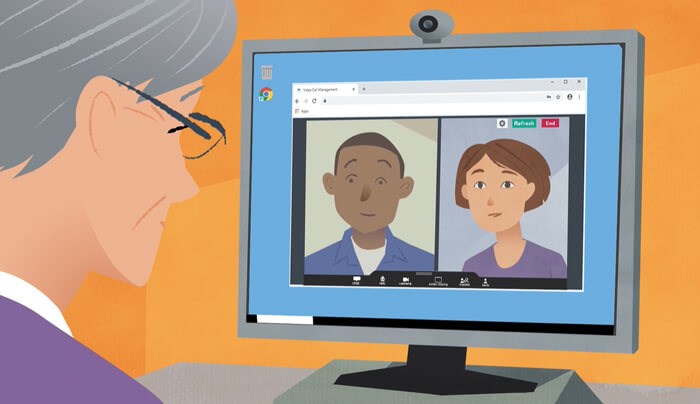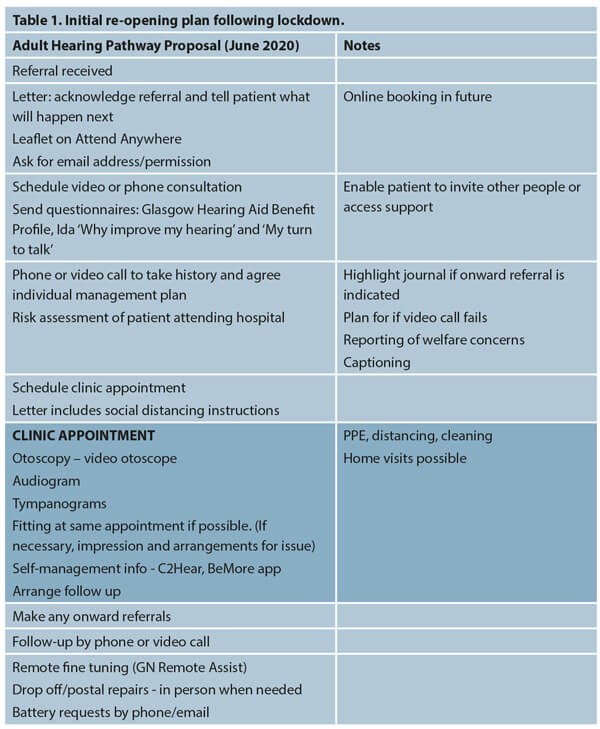March 2020 introduced the concept of lockdown to audiology services in the NHS, prompting a rethink of how to best provide hearing care. In this issue, we hear from Hanna Jeffery, a Clinical Scientist working at the Royal Glamorgan Hospital in Wales, about this experience and the introduction of telecare in their department.
It all happened very quickly. On 13 March, I had a day of clinics and meetings; by 17 March, all appointments had been cancelled. We didn’t know how long the lockdown would last for, or whether we would be redeployed. Feelings swung between seizing the moment to complete unfinished projects and struggling to fill working days, especially for more junior clinical staff.
The disorientation was alleviated for a while by non-clinical duties. But, quickly, we needed to find some positive momentum to lift morale; ideally training for staff at all levels.

Attend Anywhere video calling system. Image ©Attend Anywhere.
Even before plans to reopen the department had begun, we were starting to meet some of our patients’ needs using telephone calls. It was clear that remote care would be an integral part of our plans for the immediate future – and if we were going to bring telecare into our service, then it should not just be as a temporary measure. Table 1 shows our plan for introducing telecare into our adult rehabilitation pathway.
Telecare is a method of working that all new staff entering audiology should now expect to use in clinic.
“Quickly we needed to find some positive momentum to lift morale; ideally training for staff at all levels.”
The British Academy of Audiology Service Quality Committee and the Manchester Centre for Audiology and Deafness quickly recognised the widespread change. The result was guidance on remote working, with signposting to all the resources needed to bring telecare into the clinic with a positive and long-term view [1].
Telecare has been waiting in the wings for some years to be accepted by the mainstream. I have followed with interest the articles on telecare featured in ENT & Audiology News. The Ida Institute provides some of the most well-recognised training [2] and was something I intended to complete if time ever allowed. Suddenly, in lockdown, telecare was no longer an optional extra, but the way things needed to be – and we had time to do the preparation. I had no hesitation in recommending the Ida Learning Hall to all staff.
The Ida Telecare course comprises six modules and a multiple-choice assessment, and takes around five-to-six hours to complete; just a little too long to be completed in a single study session. Each module is taught using slides and short videos, formatted and subtitled in a consistent and professional style, and simple to navigate. The course content is available for free, with a small fee for CPD certification, if wanted.
Here are some thoughts from staff on their experiences with Ida courses:
“The courses were ideal for working around home schooling. I was able to dip in and out whenever I had time. There is overlap between the courses, so I gained a much fuller understanding from completing several courses. I entered the Telecare course with some scepticism, and it has helped to alleviate some of my worries.”
“I enjoyed doing the courses on Ida. I thought was it was possibly aimed more at the private sector, where more time can be spent with the patient and they attend more individual appointments; we try to get the pathway completed in as few appointments as possible. The problem we may have is our poor internet strength - I worry about losing connection, especially in sites furthest away from the server.”
“It is great that the tools are free online. We will need to consider how to share these with our patients as we don’t normally have their email addresses and our website isn’t able to support many links.”
“I found the Ida courses useful and informative. The Person-Centred Care course was good, and something which we could use. Getting the patient and family involved in their care is important. The only downfall with the tools would be time constraints in appointments.”
“I agree that the Telecare course is great, although setting up the clinic exactly as Ida suggest is not possible with our time constraints. I would love to use the tools provided by Ida, they seem very useful. I thought the explanations in the courses were thorough, always putting the patient first; it is a good reminder.”
The Attend Anywhere video calling system has been increasingly used during lockdown throughout Wales [3]. Our staff have now trained to use the Attend Anywhere software, and orders have been placed for sufficient equipment to offer video calls routinely.

The push to embrace telecare, like any significant change, is unlikely to be without resistance. The mixed views of audiologists have formed the basis of several studies [4] and continue to be the subject of research. The area my department serves includes some rural and less advantaged areas where video calling technology may not be widely used, especially by older adults. Compared to other areas of healthcare, our patients have greater need of good audibility and captioning. Learning how to do video calls in a practical sense may not be difficult, but success relies on making staff and patients confident that this is a positive and accessible development. Completing the Ida course was just the beginning of this process.
“Suddenly, in lockdown, telecare was no longer an optional extra, but the way things needed to be – and we had time to do the preparation”
Within Wales, we are proud to audit our services against the Wales Quality Standards [5]. If we can demonstrate some positive outcomes from the introduction of telecare, this will go a long way towards gaining the support of staff. I am currently drawing up a plan to assess some key Quality Standard criteria against our 2019 departmental assessment results. The aim is to learn where and why remote care does not work well for some aspects of audiology, and where telecare impacts positively on the quality of our service.
References
1. British Academy of Audiology. A guide to remote working in Audiology.
www.baaudiology.org/
a-guide-to-remote-working-in-audiology-
services-during-covid-19-and-beyond/
2. Ida Institute.
https://idainstitute.com
3. GIG Cymru NHS Wales. NHS Wales Attend Anywhere.
https://wales.nhs.attendanywhere.com/
resourcecentre/Content/Home.htm
4. Ravi R, Gunjawate DR, Yerraguntla K, Driscoll C. Knowledge and Perceptions of Teleaudiology Among Audiologists: A Systematic Review. J Audiol Otol 2018;22(3):120-7.
5. GIG Cymru NHS Wales. Quality Standards for Adult Hearing Rehabilitation Services.
https://gov.wales/sites/default/
files/publications/2019-10/quality-
standards-for-adults-hearing-services-
the-assessment-and-audit-tool.pdf
All reference links last accessed September 2020.





